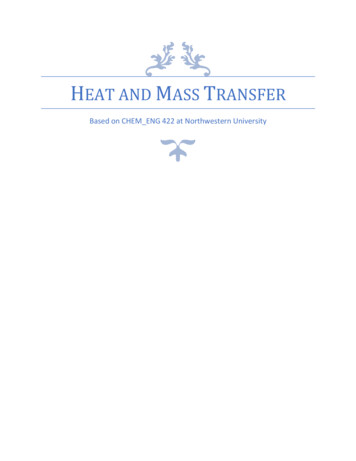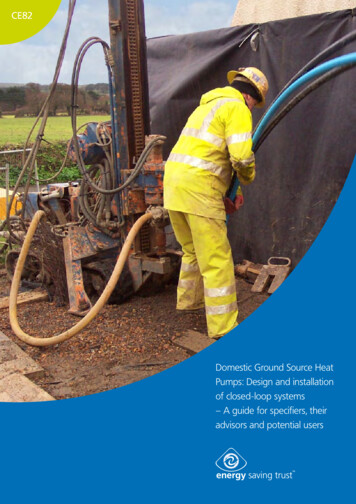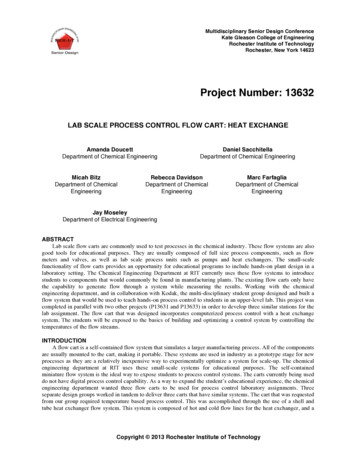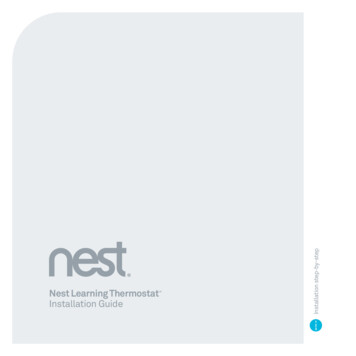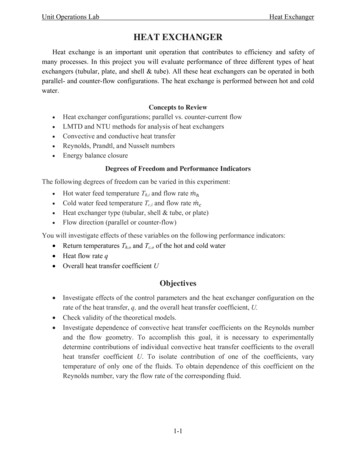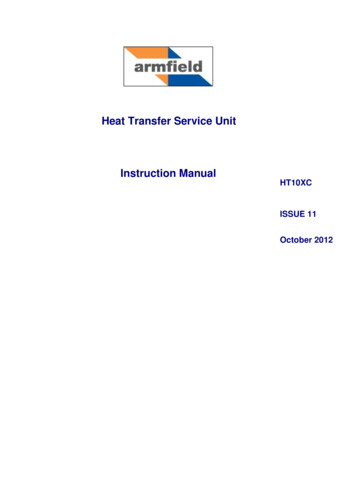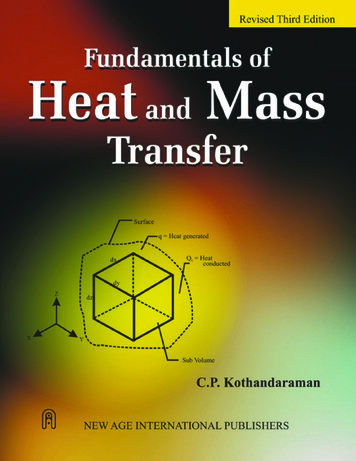
Transcription
This pageintentionally leftblank
Copyright 2006, 1999, 1994, New Age International (P) Ltd., PublishersPublished by New Age International (P) Ltd., PublishersAll rights reserved.No part of this ebook may be reproduced in any form, by photostat, microfilm,xerography, or any other means, or incorporated into any information retrievalsystem, electronic or mechanical, without the written permission of the publisher.All inquiries should be emailed to rights@newagepublishers.comISBN (13) : 978-81-224-2642-7PUBLISHING FOR ONE WORLDNEW AGE INTERNATIONAL (P) LIMITED, PUBLISHERS4835/24, Ansari Road, Daryaganj, New Delhi - 110002Visit us at www.newagepublishers.com
PREFACE TO THE THIRD EDITIONProfessor Obert has observed in his famous treatise on Thermodynamics that concepts arebetter understood by their repeated applications to real life situations. A firm conviction ofthis principle has prompted the author to arrange the text material in each chapter in thefollowing order.In the first section after enunciating the basic concepts and laws mathematical modelsare developed leading to rate equations for heat transfer and determination of temperaturefield, simple and direct numerical examples are included to illustrate the basic laws. Morestress is on the model development as compared to numerical problems.A section titled “SOLVED PROBLEMS” comes next. In this section more involvedderivations and numerical problems of practical interest are solved. The investigation of theeffect of influencing parameters for the complete spectrum of values is attempted here. Problemsinvolving complex situations are shown solved in this section. Two important ideas are stressedin this section. These are checking of dimensional homogeneity in the case of all equationsderived and the validation of numerical answers by cross checking. This concept of validationin professional practice is a must in all design situations.In the next section objective type questions are given. These are very useful forunderstanding the basis and resolving misunderstandings.In the final section a large number of graded exercise problems involving simple tocomplex situations are included.In the first of the 14 chapters the basic laws for the three modes of heat transfer areintroduced and the corresponding rate equations are developed. The use of electrical analogyis introduced and applied to single and multimode heat transfer situations. The need for iterativeworking is stressed in the solved problems.The second chapter deals with one dimensional steady state conduction. Mathematicalmodels are developed by the three geometries namely Plate, Hollow Cylinder and Hollow Sphere.Multilayer insulation is also discussed. The effect of variation of thermal conductivity on heattransfer and temperature field is clearly brought out. Parallel flow systems are discussed.Examples on variation of area along the heat flow direction are included. The use of electricalanalogy is included in all the worked examples. The importance of calculating the temperaturegradient is stressed in many of the problems.In the third chapter models for conduction with heat generation are developed for threegeometric configurations namely plate, cylinder and sphere. The effect of volume to surfacearea and the convection coefficient at the surface in maintaining lower material temperatureis illustrated. Hollow cylindrical shape with different boundary conditions is discussed.Conduction with variable heat generation rate is also modelled.Fins/extended surface or conduction-convection situation is discussed in the fourthchapter. Models for heat transfer and temperature variation are developed for four different
viPREFACEboundary conditions. Optimisation of the shape of the fin of specified volume for maximumheat flow is discussed. Circumferential fins and variable area fins are analysed. The use ofnumerical method is illustrated. Error in measurement of temperature using thermometer iswell discussed. The possibility of measurement of thermal conductivity and convective heattransfer coefficient using fins is illustrated.Two dimensional steady state conduction is discussed in the fifth chapter. Exact analysisis first developed for two types of boundary conditions. The use of numerical method is illustratedby developing nodal equations. The concept and use of conduction shape factor is illustratedfor some practical situations.One dimensional transient (unsteady) heat conduction is discussed in Chapter 6. Threetypes of models arise in this case namely lumped heat capacity system, semi-infinite solid andinfinite solid. Lumped heat capacity model for which there are a number of industrialapplications is analysed in great detail and problems of practical interest are shown solved.The condition under which semi-infinite solid model is applicable as compared to infinite solidmodel is clearly explained. Three types of boundary conditions are analysed. Infinite solidmodel for three geometric shapes is analysed next. The complexity of the analytical solution isindicated. Solution using charts is illustrated in great detail. Real solids are of limiteddimensions and these models cannot be applied directly in these cases. In these cases productsolution is applicable. A number of problems of practical interest for these types of solids areworked out in this section. In both cases a number of problems are solved using numericalmethods. Periodic heat flow problems are also discussed.Concepts and mechanism of convection are discussed in the seventh chapter. Afterdiscussing the boundary layer theory continuity, momentum and energy equations are derived.Next the different methods of solving these equations are discussed. In addition to the exactanalysis approximate integral method, analogy method and dimensional analysis are alsodiscussed and their applicability is indicated. General correlations for convective heat transfercoefficient in terms of dimensionless numbers are arrived at in this chapter.In Chapter 8, in addition to the correlations derived in the previous chapter, empiricalcorrelations arrived at from experimental results are listed and applied to flow over surfaceslike flat plate, cylinder, sphere and banks of tubes. Both laminar and turbulent flows situationare discussed.Flow through ducts is discussed in Chapter 9. Empirical correlations for various situationsare listed. Flow developing region, fully developed flow conditions, constant wall temperatureand constant wall heat flux are some of the conditions analysed. Flow through non-circularpipes and annular flow are also discussed in this chapter.Natural convection is dealt with in Chapter 10. Various geometries including enclosedspace are discussed. The choice of the appropriate correlation is illustrated through a numberof problems. Combined natural and forced convection is also discussed.Chapter 11 deals with phase change processes. Boiling, condensation, freezing andmelting are discussed. Basic equations are derived in the case of freezing and melting andcondensation. The applicable correlations in boiling are listed and their applicability isillustrated through numerical examples.Chapter 12 deals with heat exchangers, both recuperative and regenerative types. TheLMTD and NTU-effectiveness methods are discussed in detail and the applicability of thesemethods is illustrated. Various types of heat exchangers are compared for optimising the size.
PREFACEviiThermal radiation is dealt with in Chapter 13. The convenience of the use of electricalanalogy for heat exchange among radiating surfaces is discussed in detail and is applied inalmost all the solved problems. Gas radiation and multi-body enclosures are also discussed.Chapter 14 deals with basic ideas of mass transfer in both diffusion and convectionmodes. A large number of problems with different fluid combinations are worked out in thischapter.A large number of short problems and fill in the blank type and true or false typequestions are provided to test the understanding of the basic principles.Author
This pageintentionally leftblank
CONTENTSvPreface to the Third Edition1AN OVERVIEW OF HEAT TRANSFER1–251.0Introduction 11.1Heat Transfer 11.2Modes of Heat Transfer 21.3Combined Modes of Heat Transfer 81.4Dimensions and Units 101.5Closure 11Solved Problems 11Exercise Problems 222STEADY STATE CONDUCTION26–982.02.12.22.32.4Conduction 26The General Model for Conduction Study 26Steady Conduction in One Direction (One Dimensional) 30Conduction in Other Shapes 41One Dimensional Steady State Heat Conduction with Variable HeatConductivity or Variable Area Along the Section 422.5Critical Thickness of Insulation 482.6Mean Area Concept 502.7Parallel Flow 51Solved Problems 53Objective Questions 92Exercise Problems 933CONDUCTION WITH HEAT GENERATION3.03.199–127Introduction 99Steady State One Dimensional Conduction in a Slab with Uniform HeatGeneration 993.2Steady State Radial Heat Conduction in Cylinder with Uniform Heat Generation 1033.3Radial Conduction in Sphere with Uniform Heat Generation 1073.4Conclusion 109Solved Problems 110Objective Questions 125Exercise Problems 125
x4CONTENTSHEAT TRANSFER WITH EXTENDED SURFACES (FINS)128–1754.0Introduction 1284.1Fin Model 1294.2Temperature Calculation 1304.3Heat Flow Calculation 1344.4Fin Performance 1394.5Circumferential Fins and Plate Fins of Varying Sections 1424.6Optimisation 1454.7Fin with Radiation Surroundings 1464.8Contact Resistance 1464.9Numerical Method 147Solved Problems 148Objective Questions 170Exercise Problems 1725TWO DIMENSIONAL STEADY HEAT CONDUCTION176–2015.0Introduction 1765.1Solution to Differential Equation 1765.2Graphical Method 1825.3Numerical Method 1845.4Electrical Analogy 1875.5In the Finite Difference Formulation 187Solved Problems 188Exercise Problems 1996TRANSIENT HEAT CONDUCTION6.06.16.26.36.46.5202–284Introduction 202A Wall Exposed to the Sun 202Lumped Parameter Model 203Semi Infinite Solid 207Periodic Heat Conduction 213Transient Heat Conduction in Large Slab of Limited Thickness, Long Cylindersand Spheres 2156.6. Product Solution 2276.7Numerical Method 2306.8Graphical Method 233Solved Problems 234Objective Questions 278Exercise Problems 280
CONTENTS7CONVECTIONxi285–3337.0Introduction 2857.1Mechanism of Convection 2857.2The Concept of Velocity Boundary Layer 2877.3Thermal Boundary Layer 2897.4Laminar and Turbulent Flow 2917.5Forced and Free Convection 2927.6Methods Used in Convection Studies 2937.7Energy Equation 2997.8Integral Method 3027.9Dimensional Analysis 3037.10 Analogical Methods 3067.11 Correlation of Experimental Results 307Solved Problems 308Objective Questions 331Exercise Problems 3328CONVECTIVE HEAT TRANSFER—PRACTICAL CORRELATIONS—FLOW OVER SURFACES334–3848.0Introduction 3348.1Flow Over Flat Plates 3348.2Turbulent Flow 3438.3Flow Across Cylinders 3488.4Flow Across Spheres 3568.5Flow Over Bluff Bodies 3598.6Flow Across Bank of Tubes 360Solved Problems 363Objective Questions 380Exercise Problems 3819FORCED CONVECTION9.0Internal Flow 3859.1Hydrodynamic Boundary Layer Development 3869.2Thermal Boundary Layer 3879.3Laminar Flow 3889.4Turbulent Flow 3999.5Liquid Metal Flow 4029.6Flow Through Non-circular Sections 4049.7The Variation of Temperature Along the Flow Direction 406Solved Problems 408Objective Questions 431Exercise Problems 432385–433
xii10CONTENTSNATURAL CONVECTION434–47910.0 Introduction 43410.1 Basic Nature of Flow Under Natural Convection Conditions 43510.2 Methods of Analysis 43710.3 Integral Method 43910.4 Correlations from Experimental Results 44210.5 A More Recent Set of Correlations 44610.6 Constant Heat Flux Condition—Vertical Surfaces 44710.7 Free Convection from Inclined Surfaces 45110.8 Horizontal Cylinders 45410.9 Other Geometries 45510.10 Simplified Expressions for Air 45610.11 Free Convection in Enclosed Spaces 45810.12 Rotating Cylinders, Disks and Spheres 45910.13 Combined Forced and Free Convection 460Solved Problems 461Objective Questions 477Exercise Problems 47711PHASE CHANGE PROCESSES—BOILING, CONDENSATIONFREEZING AND MELTING480–52011.0 Introduction 48011.1 Boiling or Evaporation 48011.2 The correlations 48311.3 Flow Boiling 48511.4 Condensation 48811.5 Freezing and Melting 494Solved Problems 494Objective Questions 516Exercise Problems 51812HEAT oduction 521Over All Heat Transfer Coefficient 521Classification of Heat Exchangers 524Mean Temperature Difference—Log Mean Temperature Difference 526Regenerative Type 531Determination of Area in Other Arrangements 531Heat Exchanger Performance 535Storage Type Heat Exchangers 547Compact Heat Exchangers 550521–577
CONTENTSxiiiSolved Problems 550Objective Questions 572Exercise Problems 57413THERMAL RADIATION578–65513.0 Introduction 57813.1 Black Body 57913.2 Intensity of Radiation 58313.3 Real Surfaces 58413.4 Radiation Properties of Gases—Absorbing, Transmitting and Emitting Medium 58713.5 Heat Exchange by Radiation 59513.6 Radiant Heat Exchange Between Black Surfaces 60413.7 Heat Exchange by Radiation Between Gray Surfaces 60613.8 Effect of Radiation on Measurement of Temperature by a Bare Thermometer 61313.9 Multisurface Enclosure 61413.10 Surfaces Separated by an Absorbing and Transmitting Medium 617Solved Problems 618Objective Questions 648Exercise Problems 65014MASS TRANSFER14.014.114.214.314.414.514.6Introduction 656Properties of Mixture 656Diffusion Mass Transfer 657Fick’s Law of Diffusion 657Equimolal Counter Diffusion 659Stationary Media with Specified Surface Concentration 660Diffusion of One Component into a Stationary Component orUnidirectional Diffusion 66114.7 Unsteady Diffusion 66114.8 Convective Mass Transfer 66214.9 Similarity Between Heat and Mass Transfer 664Solved Problems 664Exercise Problems 680Fill in the Blanks 682State True or False 699Short Questions 702Appendix 707References 712656–701
This pageintentionally leftblank
Unit Conversion ConstantsQuantityS.I. to EnglishEnglish to S.I.Length1 m 3.2808 ft1 ft 0.3048 mArea1 m2 10.7639 ft21 ft2 0.0929 m2Volume1 m3 35.3134 ft31 ft3 0.02832 m3Mass1 kg 2.20462 lb1 lb 0.4536 kgDensity1 kg/m3 0.06243 lb/ft31 lb/ft3 16.018 kg/m3Force1 N 0.2248 lbf1 lbf 4.4482 NPressure1 N/m2 1.4504 10–4 lbf /in21 lbf /in2 6894.8 N/m2Pressure1 bar 14.504 lbf /in21 lbf /in2 0.06895 barEnergy1 kJ 0.94783 Btu1 Btu 1.0551 kJ(heat, work)1 kW hr 1.341 hp hr1 hp hr 0.7457 kW hrPower1 W 1.341 10–3 hp1 hp 745.7 WHeat flow1 W 3.4121 Btu/hr1 Btu/hr 0.29307 WSpecific heat1 kJ/kg C 0.23884 Btu/lb F1 Btu/lb F 4.1869 kJ/kg CSurface tension1 N/m 0.068522 lbf /ft1 lbf /ft 14.5939 N/mThermal conductivity1 W/m C 0.5778 Btu/hr ft F1 Btu/hrft F 1.7307 W/m CConvection coefficient1 W/m2 C 0.1761 Btu/hrft2 F1 Btu/hr ft2 F 5.6783 W/m2 CDynamic viscosity1 kg/ms 0.672 lb/fts 2419.2 lb/ft hr1 lb/fts 1.4881 kg/msor Ns/m2Kinematic viscosity1 m2/s 10.7639 ft2/s1 ft2/s 0.092903 m2/sUniversal gas const.8314.41 J/kg mol K 1545 ft lbf /mol R 1.986 B tu/lb mol RStefan Boltzmann const.5.67 W/m2K4 0.174 Btu/hr ft2 R4
xviUNIT CONVERSION CONSTANTSQuantityS.I. to MetricMetric to S.I.Force1 N 0.1019 kgf1 kgf 9.81 NPressure1 N/m2 10.19 10–6 kgf /cm21 kgr /cm2 98135 N/m2Pressure1 bar 1.0194 kgf /cm21 kgf /cm2 0.9814 barEnergy(heat, work)1 kJ 0.2389 kcal1 Nm ( 1 J) 0.1019 kgf m1 kcal 4.186 kJ1 kgf m 9.81 Nm (J)Energy(heat, work)1 kWhr 1.36 hp hr1 hp hr 0.736 kW hrPower (metric)1 W 1.36 10–3 hp1 hp 736 WHeat flow1 W 0.86 kcal/hr1 kcal/hr 1.163 WSpecific heat1 kJ/kg C 0.2389 kcal/kg C1 kcal/kg C 4.186 kJ/kg CSurface tension1 N/m 0.1019 kgf /m1 kgf/m 9.81 N/mThermal conductivity1 W/m C 0.86 kcal/hrm C1 kcal/hrm C 1.163 W/m CConvection coefficient1 W/m2 C 0.86 kcal/hrm2 C1 kcal/hrm2 C 1.163 W/m2 CDynamic viscosity1 kg/ms (Ns/m2) 0.1 Poise1 poise 10 kg/ms (Ns/m2)Kinematic viscosity1 m2/s 3600 m2/hr1 m2/hr 2.778 10–4 m2/s1 Stoke cm2/s 0.36 m2/hr 10–4 m2/sUniversal gas const.8314.41 J/kg mol K 847.54 m kgf/kg mol K 1.986 kcal/kg mol KGas constant in air (SI) 287 J/kg KStefan Boltzmann const.5.67 10–8 W/m2 K4 4.876 10–8 kcal/hr m2 K4
AN OVERVIEW OF HEAT TRANSFER1.0 INTRODUCTIONThe present standard of living is made possible by the energy available in the form of heatfrom various sources like fuels. The process by which this energy is converted for everyday useis studied under thermodynamics, leaving out the rate at which the energy is transferred. Inall applications, the rate at which energy is transferred as heat, plays an important role. Thedesign of all equipments involving heat transfer require the estimate of the rate of heat transfer.There is no need to list the various equipments where heat transfer rate influences theiroperation.The driving potential or the force which causes the transfer of energy as heat is thedifference in temperature between systems. Other such transport processes are the transfer ofmomentum, mass and electrical energy. In addition to the temperature difference, physicalparameters like geometry, material properties like conductivity, flow parameters like flowvelocity also influence the rate of heat transfer.The aim of this text is to introduce the various rate equations and methods ofdetermination of the rate of heat transfer across system boundaries under different situations.1.1 HEAT TRANSFERThe study of heat transfer is directed to (i) the estimation of rate of flow of energy as heatthrough the boundary of a system both under steady and transient conditions, and (ii) thedetermination of temperature field under steady and transient conditions, which also willprovide the information about the gradient and time rate of change of temperature at variouslocations and time. i.e. T (x, y, z, τ) and dT/dx, dT/dy, dT/dz, dT/dτ etc. These two are interrelated,one being dependent on the other. However explicit solutions may be generally required forone or the other.The basic laws governing heat transfer and their application are as below:1. First law of thermodynamics postulating the energy conservation principle: Thislaw provides the relation between the heat flow, energy stored and energy generated in agiven system. The relationship for a closed system is: The net heat flow across the systembondary heat generated inside the system change in the internal energy, of thesystem. This will also apply for an open system with slight modifications.The change in internal energy in a given volume is equal to the product of volumedensity and specific heat ρcV and dT where the group ρcV is called the heat capacity of thesystem. The basic analysis in heat transfer always has to start with one of these relations.1Chapter 11
2FUNDAMENTALS OF HEAT AND MASS TRANSFER2. The second law of thermodynamics establishing the direction of energy transportas heat. The law postulates that the flow of energy as heat through a system boundary willalways be in the direction of lower temperature or along the negative temperature gradient.3. Newtons laws of motion used in the determination of fluid flow parameters.4. Law of conservation of mass, used in the determination of flow parameters.5. The rate equations as applicable to the particular mode of heat transfer.1.2 MODES OF HEAT TRANSFER1.2.1. Conduction: This is the mode of energy transfer as heat due to temperaturedifference within a body or between bodies in thermal contact without theinvolvement of mass flow and mixing. This is the mode of heat transfer through solidbarriers and is encountered extensively in heat transfer equipment design as well as in heatingand cooling of various materials as in the case of heat treatment. The rate equation in thismode is based on Fourier’s law of heat conduction which states that the heat flow byconduction in any direction is proportional to the temperature gradient and areaperpendicular to the flow direction and is in the direction of the negative gradient.The proportionality constant obtained in the relation is known as thermal conductivity, k, ofthe material. The mathematical formulation is given in equation 1.1.Heat flow,Q – kA dT/dx.(1.1)The units used in the text for various parameters are:Q – W, (Watt), A – m2, dT – C or K (as this is only temperature interval, C and K canbe used without any difficulty). x – m, k – W/mK.For simple shapes and one directional steady conditions with constant value of thermalconductivity this law yields rate equations as below:1. Conduction, Plane Wall (Fig. 1.1), the integration of the equation 1.1 for a planewall of thickness, L between the two surfaces at T1 and T2 under steady condition leads toequation 1.2. The equation can be considered as the mathematical model for this problem.T1 T2.(1.2)( L / kA )Example 1.1: Determine the heat flow across a plane wall of 10 cm thickness with a constantthermal conductivity of 8.5 W/mK when the surface temperatures are steady at 100 C and30 C. The wall area is 3m2. Also find the temperature gradient in the flow direction.Q Solution: Refer to Fig. 1.1 and equation 1.2:T1 100 C,T2 30 C, L 10 cm 0.1 m,k 8.5 W/mK, A 3 m2.Therefore, heat flow, Q (100 – 30) / (0.1/(8.5 3)) 17850 W or 17.85 kW.Referring to equation 1.1Q – kA dT/dx17850 W – 8.5 3 dT/dx.ThereforedT/dx – 17850/(8.5 3) – 700 C/mkT1QT2x1Lx2Fig. 1.1. Physical model forexample 1.1
This is also equal to – (100 – 30)/0.1 – 700 C/m, as the gradient is constant all throughthe thickness.QT1T2IV1L/kA(a)V2R(b)Fig. 1.2. Electrical analogy (a) conduction circuit (b) Electrical circuit.The denominator in equation 1.2, namely L/kA can be considered as thermal resistancefor conduction. An electrical analogy is useful as a concept in solving conduction problemsand in general heat transfer problems.1.2.2. Thermal Conductivity: It is the constant of proportionality in Fourier’s equation andplays an important role in heat transfer. The unit in SI system for conductivity is W/mK. It isa material property. Its value is higher for good electrical conductors and single crystals likediamond. Next in order or alloys of metals and non metals. Liquids have conductivity less thanthese materials. Gases have the least value for thermal conductivity.In solids heat is conducted in two modes. 1. The flow of thermally activated electronsand 2. Lattice waves generated by thermally induced atomic activity. In conductors thepredominant mode is by electron flow. In alloys it is equal between the two modes. In insulators,the lattice wave mode is the main one. In liquids , conduction is by atomic or molecular diffusion.In gases conduction is by diffusion of molecules from higher energy level to the lower level.Thermal conductivity is formed to vary with temperature. In good conductors, thermalconductivity decreases with temperature due to impedance to electron flow of higherelectron densities. In insulators, as temperature increases, thermal atomic activity alsoincreases and hence thermal conductivity increases with temperature. In the case ofgases, thermal conductivity increases with temperature due to increased random activityof atoms and molecules. Thermal conductivity of some materials is given in table 1.1.Table 1.1. Thermal conductivity of some materials at 293 KMaterialThermal conductivity, W/mKCopper386.0Aluminium204.2Carbon Steel 1% C43.3Chrome Steel 20% Cr22.5Chrome Nickel 1Air0.026Chapter 13AN OVERVIEW OF HEAT TRANSFER
4FUNDAMENTALS OF HEAT AND MASS TRANSFERThe variation of thermal conductivity of various materials with temperature is shownin Fig. Magnesium(pure)Iron(pure)Thermal conductivity k, (W/m C)LeadMercuryAluminum ay brick(burned 1330 C)WatergenHydro0.1Asbestos sheets(40 laminations/m)Engine oilAirCO20.01SolidsLiquidsGases(at atm press)0.0011000100 200 300 400500 600 700 800 900 1000Temperature, CFig. 1.3. Effect of temperature on thermal conductivity of materials.1.2.3. Thermal Insulation: In many situations to conserve heat energy, equipments have tobe insulated. Thermal insulation materials should have a low thermal conductivity. This isachieved in solids by trapping air or a gas in small cavities inside the material. It may also beachieved by loose filling of solid particles. The insulating property depends on the material aswell as transport property of the gases filling the void spaces. There are essentially three typesof insulating materials:1. Fibrous: Small diameter particles or filaments are loosely filled in the gap betweensurfaces to be insulated. Mineral wool is one such material, for temperatures below 700 C.Fibre glass insulation is used below 200 C. For higher temperatures refractory fibres likeAlumina (Al2O3) or silica (S1O2) are useful.2. Cellular: These are available in the form of boards or formed parts. These containvoids with air trapped in them. Examples are polyurethane and expanded polystyrene foams.3. Granular: These are of small grains or flakes of inorganic materials and used inpreformed shapes or as powders.The effective thermal conductivity of these materials is in the range of 0.02 to 0.04W/mK.
1.2.4. Contact Resistance: When twodifferent layers of conducting materials areplaced in thermal contact, a thermalresistance develops at the interface. Thisis termed as contact resistance. Asignificant temperature drop develops atthe interface and this has to be taken intoaccount in heat transfer calculation. Thecontact resistance depends on the surfaceroughness to a great extent. The pressureholding the two surfaces together alsoinfluences the contact resistance. When thesurfaces are brought together the contactis partial and air may be trapped betweenthe other points as shown in Fig. 1.4.Solid AInsulatedSolid BGap between solidsT1Solid ASolid BT2QQ0xInsulatedTT1Tc1Tc2 TT20Some values of contact resistance fordifferent surfaces is given in table 1.2.xFig. 1.4. Contact resistance temperature dropTable 1.2.Pressure atmR, m2 C/W 104Roughness µmTemp.Stainless Steel ground in air2.5420-2003-252.64Stainless Steel ground in air1.1420 40-705.28Aluminium ground air2.5415012-250.88Aluminium ground air0.2515012-250.18.Surface type1.2.5. Convection: This mode of heat transfer is met with in situations where energy istransferred as heat to a flowing fluid at the surface over which the flow occurs. This mode isbasically conduction in a very thin fluid layer at the surface and then mixing caused by theflow. The energy transfer is by combined molecular diffusion and bulk flow. The heat flow isindependent of the properties of the material of the surface and depends only on the fluidproperties. However the shape and nature of the surface will influence the flow and hence theheat transfer. Convection is not a pure mode as conduction or radiation and hence involvesseveral parameters. If the flow is caused by external means like a fan or pump, then themode is known as forced convection. If the flow is due to the buoyant forces caused bytemperature difference in the fluid body, then the mode is known as free or natural convection.In most applications heat is transferred from one fluid to another separated by a solid surface.So heat is transferred from the hot fluid to the surface and then from the surface to the coldfluid by convection. In the design process thus convection mode becomes the most importantone in the point of view of application. The rate equation is due to Newton who clubbed all theparameters into a single one called convective heat transfer coefficient (h) as given in equation1.3. The physical configuration is shown in Fig. 1.5. (a).Chapter 15AN OVERVIEW OF HEAT TRANSFER
6FUNDAMENTALS OF HEAT AND MASS TRANSFERHeat flow,T1 T21 / hAT1, T2 C or K, h W/m2K.Q hA (T1 – T2) .(1.3)where, Q W.A m2,The quantity 1/hA is called convection resistance to heat flow. The equivalent circuit isgiven in Fig. 1.5(b).T1 T2T2Fluid flowQT1QSurfaceT1(a)T2I/hA(b)Fig. 1.5. Electrical analogy for convection heat transferExample 1.2: Determine the heat transfer by convection over a surface of 0.5 m2 area if thesurface is at 160 C and fluid is at 40 C. The value of convective heat transfer coefficient is 25W/m2K. Also estimate the temperature gradient at the surface given k 1 W/mK.Solution: Refer to Fig. 1.5a and equation 1.3Q hA (T1 – T2) 25 0.5 (160 – 40) W 1500 W or 1.5 kWThe resistance 1/hA 1/25 0.5 0.08 C/W.The fluid has a conductivity of 1 W/mK, then the temperature gradient at the surfaceisQ – kA dT/dyTherefore,dT/dy – Q/kA – 1500/1.0 0.5 – 3000 C/m.The fluid temperature is often referred as T for indicating that it is the fluid temperaturewell removed from the surface. The convective heat transfer coefficient is dependent on severalparameters and the determination of the value of this quantity is rather complex, and isdiscussed in later chapters.1.2.6. Radiation: Thermal radiation is part of the electromagnetic spectrum in the limitedwave length range of 0.1 to 10 µm and is emitted at all surfaces, irrespective of the temperature.Such radiation incident on surfaces is absorbed and thus radiation heat transfer takes placebetween surfaces at different temperatures. No medium is required for radiative transfer butthe surfaces should be in visual contact for direct radiation transfer. The rate equation is dueto Stefan-Boltzmann law which states that heat radiated is proportional to the fourth powerof the absolute temperature of the surface and heat transfer rate between surfaces is given inequation 1.4. The situation is represented in Fig. 1.6 (a).(1.4)Q F σ A (T14 – T24)where,F— a factor depending on geometry and surface properties,σ— Stefan Boltzmann constant 5.67 10–8 W/m2K4 (SI units)A— m2, T1, T2 K (only absolute unit of tempera
1 AN OVERVIEW OF HEAT TRANSFER 1–25 1.0 Introduction 1 1.1 Heat Transfer 1 1.2 Modes of Heat Transfer 2 1.3 Combined Modes of Heat Transfer 8 1.4 Dimensions and Units 10 1.5 Closure 11 Solved Problems 11 Exercise Problems 22 2 STEADY STATE CONDUCTION 26–98 2.0 Co

